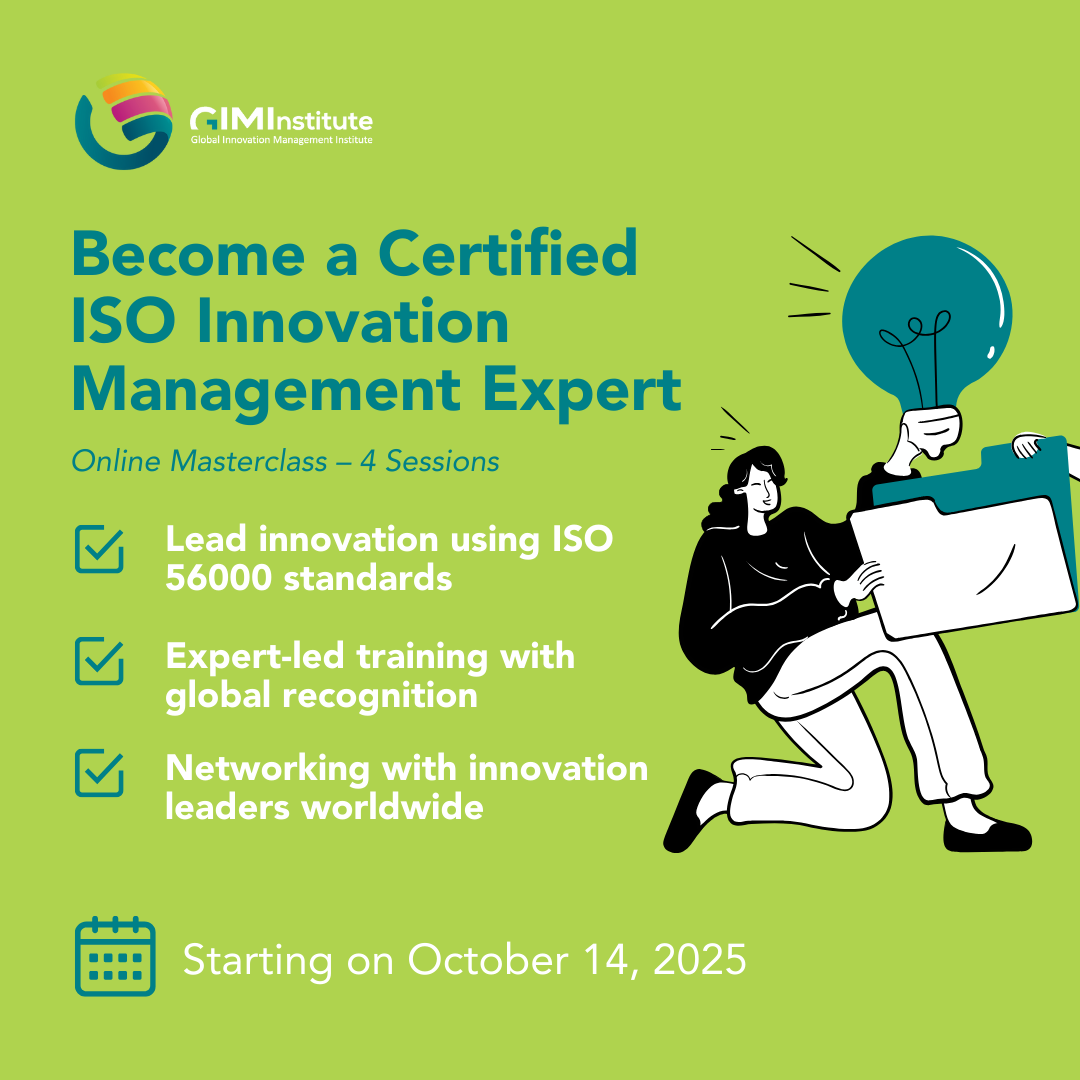The Innovation Advantage: How Assessments Drive Growth and Global Leadership – Greater than your organization
Abstract:
In an era defined by rapid technological advancement and fierce global competition, innovation is a necessity. Organizations that prioritize innovation not only achieve greater financial success but also contribute to the overall progress of their nations. An Innovation Management Assessment (IMA) can help organizations identify gaps in their innovation capabilities and create an action plan for improvement. An IMA such as ISO 56004 is a good starting point for organizations looking to assess their innovation strengths and weaknesses. IMA is also the starting point for any organization seeking growth and sustainment. Drawing on data-driven insights and real-world examples, we demonstrate how IMAs empower organizations to cultivate a culture of innovation, optimize resource allocation, and ultimately, emerge as industry leaders.
The Innovation Management Assessment Defined
An Innovation Management Assessment evaluates an organization’s capacity to generate, develop, and implement new ideas effectively. It measures the strengths and weaknesses of an organization’s innovation processes, culture, and strategy to identify areas for improvement.
How does it fit into an Innovation Management Framework
The Innovation Management Framework
An innovation management framework is a foundational set of practices and tools that helps organizations generate ideas, evaluate those ideas, and turn the best ideas into a value-added management system for business. It arranges the general steps of the innovation process into clear stages that help leaders decide whether to pivot course, pause, or continue funding the work.
At its core, an Innovation Management Framework provides 3 basic things: a set of principles, methodologies, and tools that enable business organizations to navigate the complexities of the Innovation landscape. Now, one of the underlying key components of an Innovation management Framework typically includes a set of basic processes for idea generation, evaluation, and implementation, as well as mechanisms for continuous improvement. The framework acts as a unifying structure that aligns organizational goals with creative endeavours, encouraging a culture of experimentation and adaptation.
Innovation Management Frameworks come in various forms, ranging from models that emphasize collaboration with external partners (such as open Innovation Frameworks) to methodologies like Design Thinking in business and lean startup principles, each tailored to address specific aspects of the Innovation lifecycle.
Ultimately, an Innovation Framework equips organizations with the means to stay agile in the face of rapid change, gain a competitive edge, and nurture a culture that values and embraces creative problem-solving. As businesses increasingly recognize the pivotal role of Innovation in sustaining growth, adopting robust Innovation Management Frameworks become paramount in navigating the complexities of the modern business landscape.
General Benefits of an Innovation Management Assessment
According to ISO, Innovation management assessment benefits include the following:
(a) Cost Savings & Operational Efficiency
(b) Market Share and Competitive advantage: Staying ahead of the competition
(c) Growth and expansion: Innovation drives growth and expansion
(d) Adaptation to change: Embracing innovation helps adapt to changes
(e) Improved efficiency and productivity: Innovation leads to increased efficiency
(f) Employee engagement and retention: Innovation enhances employee satisfaction
The Innovation Imperative – Why IMA
About Revenue Growth and Time to Market
Companies that prioritize innovation experience a staggering 20% increase in revenue compared to their less innovative counterparts (McKinsey & Company, 2020). Organizations with robust innovation cultures witness revenue growth rates that are 10-20% higher than their competitors (Boston Consulting Group, 2018). Innovation Management Assessments (IMAs) contribute to a remarkable 25% reduction in the time it takes to bring new products to the market (Gartner, 2020). These statistics underscore the undeniable link between innovation and financial success. But the benefits extend far beyond the bottom line.
About Cost Savings and Operational Efficiency
In today’s dynamic business landscape, efficiency is paramount. IMAs provide a structured framework for identifying and eliminating operational waste, resulting in substantial cost savings. Structured innovation assessments lead to an 18-25% reduction in operational waste (Gartner, 2021). Companies that leverage IMAs are 30% more likely to pinpoint areas for cost reduction (Gartner, 2020). Regular innovation assessments can yield a remarkable 30% savings in R&D expenditure (Gartner, 2020).
About Market Share and Competitive Advantage
In the relentless pursuit of market dominance, innovation is the ultimate differentiator. Companies that conduct periodic innovation assessments are 40% more likely to achieve sustained competitive advantage (Gartner, 2021). By conducting customer-centric assessments, businesses can identify pain points and develop tailored solutions that resonate with their target audience. Gartner’s Customer Experience and Innovation report shows that companies that incorporate customer feedback into their innovation processes are 35% more likely to capture new market share than those that don’t (Gartner, 2021). According to Gartner, companies that leverage innovation assessments to enter new markets see a 20-30% faster market share gain compared to competitors who do not systematically assess their innovation strategies (Gartner, 2020).
About Strategic Decision-Making and Digital Transformation
In an age of unprecedented change, agility and adaptability are crucial. IMAs provide organizations with the insights they need to make informed strategic decisions and navigate the complexities of digital transformation. Organizations with formalized innovation strategies experience a 30-40% surge in revenue growth (Gartner, 2020). Companies that assess their innovation maturity are 1.5 times more likely to expand their digital product offerings (Gartner, 2021).
The Global Impact of IMAs
The benefits of IMAs extend beyond individual organizations, contributing to the overall progress and competitiveness of nations. By enhancing innovation practices and R&D efficiency, IMAs boost private sector innovation rankings. Regular assessments drive education and talent development, leading to improvements in human capital scores. IDIA’s work implicitly emphasizes Innovation Management Assessment by highlighting the need for structured approaches to ensure development innovations are contextually relevant and achieve scalable impact. Effective assessments, in their view, would focus on evaluating an organization’s ability to learn, adapt, and collaborate, ensuring innovations truly address pressing global challenges. A 2022 McKinsey report highlights that companies investing in workforce innovation programs experience greater long-term growth and productivity, which ultimately contributes to national innovation rankings. Moreover, IMAs optimize innovation ecosystems, contributing to higher infrastructure development rankings.
Key Takeaways & A Call to Action
-
Unlock Your Innovation Potential: Champion Regular Innovation Assessments! Let’s empower our companies to lead the world by embracing innovation assessments as a cornerstone of their strategy. By aligning with global best practices and their own ambitious goals, we’ll unlock unprecedented growth and seize the vast opportunities that lie ahead.
-
Forge Unbreakable Alliances: Fuel Innovation Through Collaborative Power! We must bridge the gap between businesses, universities, and government, creating a dynamic ecosystem where knowledge flows freely. This powerful synergy will not only elevate our Knowledge and Technology Outputs but also propel our nation’s standing on the global stage and benefit all of society.
-
Shape the Future: Invest Boldly in Tomorrow’s Technologies! The future belongs to those who dare to invest in emerging technologies. By prioritizing these investments, we can not only maintain our competitiveness but also, we’ll unleash a wave of transformative innovation that will redefine possibilities.
In a nutshell, IMA is a valuable tool that can help organizations to improve their innovation capabilities and achieve their business goals. In light of the overwhelming evidence, it is clear that Innovation Management Assessments are not merely a tool for organizational improvement, but a catalyst for national progress. By embracing IMAs, organizations can unlock their full potential, drive economic growth, and shape a brighter future for their nations.



